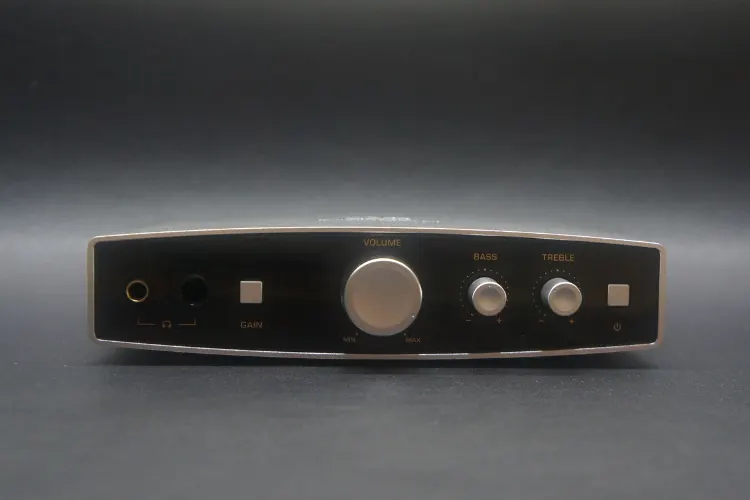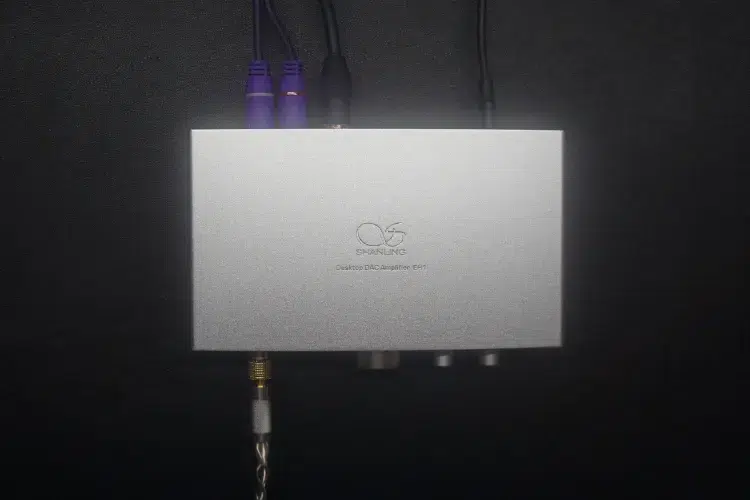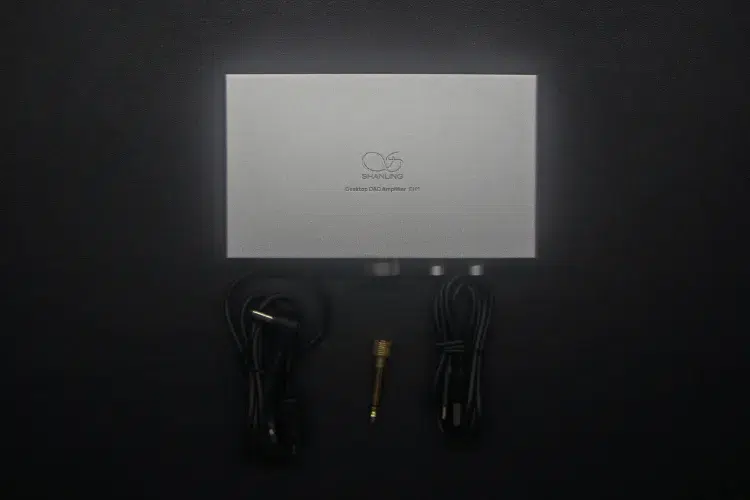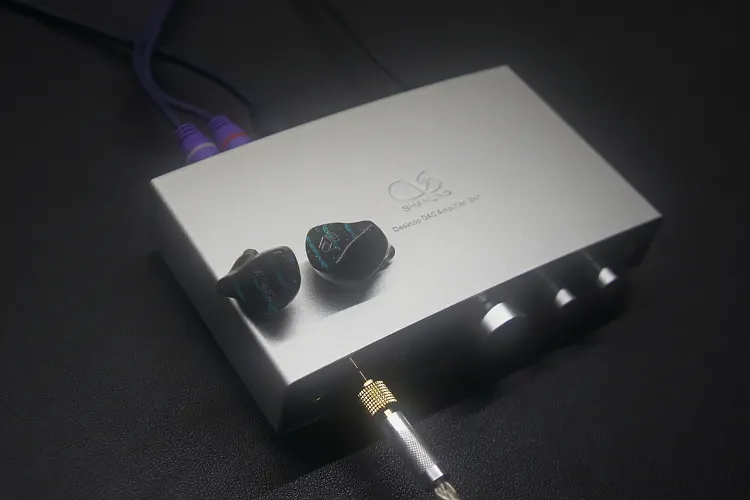Today, Meldrick reviews the Shanling EH1, a compact desktop USB DAC and headphone amplifier with up to 1015mW of balanced output power. It is priced at $219.
Disclaimer: This sample was sent to me in exchange for my honest opinion. Headfonics is an independent website with no affiliate links or status. I thank Shanling for their support.
Click here to learn more about Shanling products we previously reviewed on Headfonics.
This article follows our current scoring guidelines which you can read in more detail here.
Shanling is no stranger in the multi-function desktop space, especially with their EM5 and EH3 units.
However, Shanling is trying something new with their latest EH1, touting it as “probably the simplest device they’ve released in recent memory”. As a straightforward desktop DAC/AMP unit, its simplicity is not a bad thing.
With a comprehensive suite of input and output options and the inclusion of bass and treble tone controls, read my review below to see if the $219 EH1 has what it takes to snatch the crown from its peers in the price range.
Features
The EH1 is the first desktop DAC/AMP I have tested that comes with bass and treble tone controls.
While hardware level tone adjustment may not be to everyone’s liking, the ability to easily make quick changes to the overall sound signature is a new value add within this class of product.
Like alternative sub-$200 DAC/AMPs such as the FiiO K11, the EH1 also comes with a Cirrus Logic CS43198 DAC and a pair of SMG 8262 amplifiers, delivering a clean and detailed sound up to PCM 32BIT/768kHz or native DSD512.
While the EH1 comes with the input and output options audiophiles have become accustomed to at this price range, it also adds a coaxial output, letting users connect from USB sources to older DACs or Hi-Fi Receivers.
Design
The first thing that stands out about the EH1 upon taking it out of the box is its curved chassis. Its curvature isn’t as extreme as the shells used in the iFi Zen line of products, but it is noticeable enough to break away from a sea of rectangular audio sources that flood our hobby.
Coming in either silver or black, the unit given to us for review is the silver variety. The shell is constructed out of anodized aluminum, giving the unit a smooth finish while exuding a sleek and luxurious appeal.
The silver color of our review unit is a slightly darker shade than other anodized aluminum devices I’ve tried, resembling more like the space grey finish of laptop computers of certain “fruit” companies.
This dark grey finish contrasts well with its piano-black faceplate of the unit, housing its knobs, dials, jacks, and control buttons. The function labels across the faceplate have a subdued gold color, giving it a sleek high-end feel.
Despite the piano black finish of the faceplate, I found it to be quite resistant to fingerprints, requiring very minimal cleaning during daily use.
The unit’s rear plate is made out of anodized aluminum, housing its different input and output jacks and a line/pre-out switch.
The EH1’s aesthetics perfectly toe the line being unique enough to give it some personality and visual flare, while also being stealthy enough to fit into the most subdued desktop setups.
I/O
The Shanling EH1 has a robust set of input and output options that make it a versatile option for audiophiles building up their desktop system.
Despite it becoming more common, it is nice to see that the EH1 comes with both a SE 6.35mm jack and a 4.4mm balanced output. With more affordable IEMs and headphones now coming with balanced cables, this inclusion further aids in maximizing different headphone or IEM pairings.
The rear of the unit is where the EH1 starts to shine. Despite having only, a single USB-C port for the unit’s sole data input, it makes up for this with a versatile set of outputs.
The right of the unit houses the coaxial digital output, letting the unit act as a USB to Coaxial converter, a useful feature for those looking to pair the EH1 with vintage DACs or AV receivers.
The leftmost portion of the rear shell houses the DC Barrel jack for extra power. It is worth noting that the EH1 can be powered solely by its USB-C input, but plugging in the included DC power cable bumps up the output power on both the SE and BAL output quite substantially.
During IEM pairings, I appreciated the option of being able to use a single cable for power and data. However, when I started testing the EH1 with full-sized headphones, plugging the unit into DC power became necessary.
The rear also houses the RCA analog outputs, with a pre-out and Line-out switch right beside it.
I prefer this pre/line out selection system over the control scheme used by the FiiO K11 since this removes the need to navigate through different menus, which could be quite cumbersome during the initial setup.
Controls
The EH1 has a very simple and intuitive control scheme when compared to its competition in the price range.
The EH1 has a large satisfying volume knob up front, with the sole purpose of being used to change the volume. It does not click in or have infinite rotation; it is a simple knob with ends at 5 and 7 o’clock.
An RGB ring surrounds the volume knob, shining a different color depending on the sample rate and file type of the signal being fed into the unit.
This is a helpful feature for those who want to make sure that their high-fidelity digital source is not being resampled or downsampled as it goes through the different steps on the audio chain
The unit also has a dedicated gain button that cycles between high and low gain, as well as a dedicated power button on the rightmost side. However, the main attraction is the smaller pair of knobs to the right of the volume knob.
The EH1 is the first desktop DAC/AMP I’ve tried hardware tone controls built in. Admittedly, I was never too keen on using software EQ or the hardware tone controls on my speaker amplifier. However, the EH1 has changed my mind.
The knobs silently click into place in its neutral position, ensuring that it is always easy to go back to the EH1’s default tuning. It takes quite a bit of force to turn the knob past this point in both directions, however, the bass and tone adjustments are gradual enough to make fine-tuning a breeze.
I found myself sometimes changing the EH1’s tuning on a track-per-track basis. I never turned it past a quarter past neutral, but it helped in accentuating different instruments and coloring the sound to my preference.
Packaging & Accessories
The EH11 comes in a brown cardboard box with an outline of the device on the front and key specifications on the back.
Inside the box, you will find the EH1 unit, a USB Type-C to USB-A cable, a barrel jack to USB-A cable, a 3.5mm to 6.35mm adapter, and the standard device paperwork.
The accessories are the bare minimum needed for operation with a USB-based source. I would have also appreciated the inclusion of a USB-C to USB-C for pairing devices with more modern laptops.
It is worth noting that even though the unit can be powered by the sole USB-C data and power input, Shanling still included a DC power cable out of the box.
Users will still need to supply their own USB power brick, but the inclusion of the optional power cable already gives its accessories a better value over the iFi Audio ZEN DAC.
Sound Impressions
The following sound impressions were made with the Sennheiser HD 580, Audio Technica R70X, Moondrop Blessing 3, and Yanyin Canon II as my main headphone and IEM pairings.
Unless otherwise stated, all thoughts and comparisons were done with the bass and treble knobs at their neutral setting, and with the EH1 plugged into DC power.
Bass
The EH1 is a natural-sounding DAC/AMP with a slight tilt towards the warm end. Sub-bass hits, especially kick drums in simpler acoustic tracks, have a tight and textured presentation, but it is never played at a level that overwhelms the rest of the mix.
In more modern complex Hip-hop or pop tracks, I found myself wanting a bit more sub-bass at times. However, I did find that turning up the bass knob around 15 degrees helped counteract this.
With this warmer-sounding presentation, bass guitars and synths have a very satisfying and lush tonality to them. They envelope the sound, giving it a more relaxed signature, especially when comparing it to cleaner and more analytical sources.
Especially in more melodic pop or rock tracks, this warmer presentation of the mid-bass, alongside the tight and textured sub-bass presentation, gives the EH1 good dynamics, making tracks sound natural and engaging at the same time.
Mids
The warmth in the bass region finds its way into the mid-range. Male vocals have a very strong sense of authority and weight, giving tracks a smooth presentation.
I enjoyed listening to 80s funk and disco tracks on the EH1’s stock settings since it gave horns and synths more satisfying dynamics, without disrupting the track’s overall tonal balance.
However, the EH1 is not as proficient in playing back more delicate string instruments such as acoustic guitar or piano keys. The warmth gives these instruments a more enclosed and claustrophobic presentation.
On more female vocal-focused tracks with fewer stripped-down layers of acoustic instruments, I found myself turning down the bass knob below neutral and ever so slightly increasing the treble knob.
This opened up the sound, giving instruments a better sense of air, and improved the level of instrumental separation.
Treble
With a neutral sound signature that leans towards the warm end, the EH1 has a relaxing treble presentation that minimizes fatigue in simpler tracks but also struggles to articulate micro-detail and air compared to more neutral sources.
Throughout my testing, I never experienced any sibilance on the EH1 with the DAC on its neutral setting. In most pop tracks, I found the amount of treble perfectly sufficient and never found the presentation of chimes and cymbals to detract from the overall energy.
Even in more complex tracks with different cymbals and chimes, I found that lowering the bass slightly and increasing the treble by around 5-10 degrees improved micro detail. However, I found this configuration to be very track and genre-dependent.
In simpler, and better-mastered tracks, the treble does its job of accenting the music, but it never stands out or wows the listener. But with its tuning versatility, it can tailor the treble presentation towards different preferences that are close to neutral.
Staging and Dynamics
On the EH1’s stock tuning, the imaging is not class-leading by any means, with string instruments sounding compressed in more complex mixes, but by tweaking the bass down a few notches and slightly boosting the treble, I found that the imaging performance in the mid-range improved.
Staging is quite decent compared to its peers, it doesn’t overtly bottleneck wider-sounding headphones nor does it increase the staging performance of more intimate-sounding headphones, but it is still sufficient in playing back a 360-degree soundscape around the listener.
On its stock tuning, Instruments in the bass region have good dynamics, coming off with good note weight and authority, however, instruments in the mid-range and treble regions only have average levels of dynamics.
Click on page 2 below for my recommended pairings and selected comparisons.






